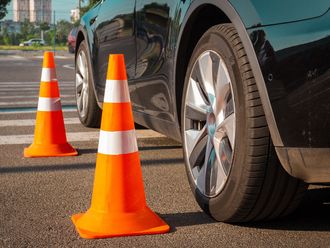
Dubai: Properly maintained car tyres can save both your money and your life. So how do you know when your car’s tyres are either in need of maintenance or have to be replaced?
The first step is prevention. Here are some simple steps you can take to make sure your car’s tyres are always in good condition.
What are the benefits of correctly maintained tyres?
As reported by Gulf News earlier , tyre maintenance can help motorists in more ways than one.
Tyres are the only part of the vehicle that come in direct contact with the road surface, which makes tyre safety critically important.
Maintaining the optimal tyre pressure not only ensures a smooth driving experience, it can also help you save on fuel, as it improves the car’s mileage. On the other hand, tyres that are worn out can be a serious road hazard, as cars are more prone to skidding or tyres bursting when the tread is worn out.
Five-point checklist for tyre safety
Gulf News spoke with Vikas Anand, general manager for tyres and batteries at Juma Al Majid Group, to find out how you can take care of your tyres. Here are five aspects that you can easily check to ensure your tyres are in good condition:
1. Check for uneven tread wear or bulges
Tyre treads are one of the first places where you can find out if there has been any damage that needs to be addressed.
“Check tyres on a regular basis for any sidewall damages like bulges or cracks on the tread," Anand said.
How to check tread wear
An easy way to find out if your tyre’s tread is worn out is by referring to the Tread Wear Indicator (TWI). Anand explained that a tyre should be discontinued once the tread depth goes lower than 1.6mm. This level is also indicated by the TWI, which you can spot on your tyre as small triangle marks.

2. Check the tyre pressure every two weeks
Anand recommends that motorists check the tyre pressure every two weeks, as per the vehicle recommendation. But what is the ideal tyre pressure for your car?
“Recommended PSI [pounds per square inch, the unit in which tyre pressure is measured] for every car is mentioned in the car manual , on the door panel of driver’s side or on the fuel latch. Now, most cars also come with a TPMS [Tyre-pressure monitoring system], which prompts the driver with a low tyre pressure warning on the dashboard,” Anand said.
He added that any driver can easily check and top up the air pressure at a petrol station or at tyre shops.
3. Rotate your tyres
Tyre rotation refers to the practice of periodically changing the position of each of the tyres on your vehicle, to ensure even wear of all four tyres. Anand recommends that motorists rotate their car’s tyres every 10,000km, which can be done at a vehicle service centre or repair shop.
“Most car manufacturers will state how often you should rotate your tyres in the car’s manual,” Anand said.
4. Avoid hard cornering
Driving too fast at turns is never a good idea. Not only do you risk losing control of your car, ‘hard cornering’ can lead to torn tyres, too, according to Anand.
"You should slow down on sharp turns and bends. When you do not slow down and turn, it affects the tyre's performance and leads to a lot of force on the tyre," he said.
5. Get wheel alignment done regularly
Wheel alignment ensures the tyres are at the right angle for your vehicle while driving. This service is usually offered by car mechanics or can also be done during your regular car service. Anand advised car owners to get their car’s wheels aligned every time they have a tyre change.
1. Uneven tread wear.
2. Cracking or cuts on the sidewall.
3. Bulges on the sidewall
4. Excessive vibration of the tyres.
Anand advised car owners to never ignore any of these warning signs and immediately get the car checked by an expert.
5 years
The lifespan of a tyre in GCC weather conditions. However, the tyre would need to be changed earlier, if the tread is worn out.
Driving in the desert? Five best practices to follow
As exciting as dune bashing can be, the desert terrain is also challenging. Anand advised motorists to get suitable tyres to withstand the climate and terrain of the desert. He shared these five tips for desert driving enthusiasts:
1. Ensure tyres are in good condition. Anand recommended motorists to opt for ‘all-terrain’ tyres, which are suitable for a desert terrain as well as on-road driving.
"Off-road tyres have bigger blocks on the tread and a reinforced stronger casing to withstand the load when vehicles are used in a deflated condition. It is advisable to use an all-terrain pattern when driving in the desert. However, for an occasional drive through the desert, regular tyres can also be used," he said.

Off-road tyres have bigger blocks on the tread and a reinforced stronger casing to withstand the load when vehicles are used in a deflated condition. It is advisable to use an all-terrain pattern when driving in the desert. However, for an occasional drive through the desert, regular tyres can also be used
2. Lower the air pressure just before entering the desert. According to Anand, this increases the ‘tyre’s footprint’, which will improve tyre's traction.
3. Tyre pressure should be topped up after the car returns to the road from the desert. You can do this if you have a portable car tyre pressure pump, or drive to the nearest petrol station to top-up the pressure.
If you are going on to a rocky terrain instead, the PSI should at the most be 35 per cent of the original tyre pressure. But, always check with an expert before setting off.









